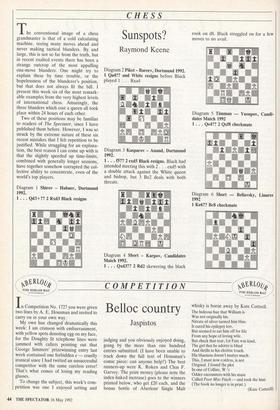CHESS
Sunspots?
Raymond Keene
The conventional image of a chess grandmaster is that of a cold calculating machine, seeing many moves ahead and never making tactical blunders. By and large, this is not so far from the truth, but in recent exalted events there has been a strange outcrop of the most appalling one-move blunders: One might try to explain these by time trouble, or the hopelessness of the blunderer's position, but that does not always fit the bill. I present this week six of the most remark- able examples from the very highest levels of international chess. Amazingly, the three blunders which cost a queen all took place within 24 hours of each other.
Two of these positions may be familiar to readers of The Spectator, since I have published them before. However, I was so struck by the extreme nature of these six recent mistakes that I felt repetition to be justified. While struggling for an explana- tion, the best reason I can come up with is that the slightly speeded up time-limits, combined with generally longer sessions, have together somehow corrupted the col- lective ability to concentrate, even of the world's top players.
Diagram 1 Shirov – Hubner, Dortmund 1992.
1. . . Qd3+?? 2 Rxd3 Black resigns Diagram 2 Piket – Bareev, Dortmund 1992. 1 Qa4?? and White resigns before Black
played 1 Rxa4
Diagram 3 Kasparov – Anand, Dortmund 1992.
1. . . f5?? 2 exd5 Black resigns. Black had intended meeting this with 2. . . exd5 with a double attack against the White queen and bishop, but 3 Be2 deals with both threats.
Diagram 4 Short – Karpov, Candidates Match 1992.
1 . . . Qxd3?? 2 Rd2 skewering the black rook on d8. Black struggled on for a few moves to no avail.
Diagram 5 Timman — Vusupov, Candi- dates Match 1992 1 . . . Qe4?? 2 Qxf8 checkmate Diagram 6 Short — Beliavsky, Linares 1992 1 Ke6?? Bc8 checkmate


















































 Previous page
Previous page